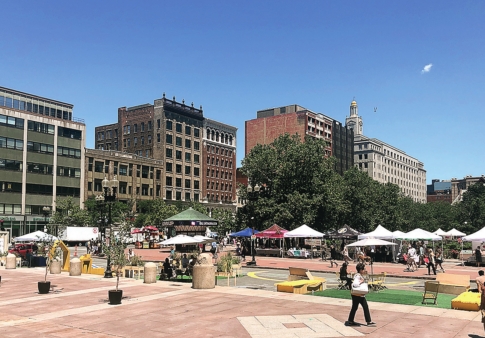

The Wu administration is declaring its pilot conversion of Copley Square into a pedestrian zone successful, moving to the experiment’s next stage despite objections from many neighbors.
The weeklong pilot conversion took place in June, with planners shutting down Dartmouth Street in front of the Boston Public
Library’s main branch and using it for events like dance classes, food trucks, yoga, and music.
The experiment also gave the city a chance to weigh public opinion and gather traffic data. While officials are claiming success, residents of the surrounding area have assailed the study as biased and misguided.
The city’s numbers show peak visitor ship hovering at roughly 80 people per hour. Officials logged around 1000 interactions with constituents to discuss the proposal, and most of those responses were strongly in favor of converting the street into a pedestrian zone long-term.
City data shows that median car trips were delayed by around a minute by the event, worse on some streets than others and more severe during rush hour. It also does suggest that some drivers were avoiding the area while the street was closed.
Some of the project's neighbors have criticized the study as nonrepresentative. It was conducted in June, when school was out for the summer and many Back Bay residents were on vacation. It also took place in the middle of a pandemic when many were working from home instead of commuting.
“We’ve certainly expressed substantial skepticism about the impacts of a permanent closure, particularly the traffic,” said Elliot Laffer, chair of the Neighborhood Association of the Back Bay.
“We’re skeptical that the claim it only adds a little congestion to Berkeley Street really reflects the potential impact, since testing was done when few people were in the office. Is it really representative to do a study in a lower-traffic month once students leave town and people start taking vacations?”
NABB has opposed the project, although city planners will be presenting their new findings at NABB’s February meeting in the hopes of changing that.
The Friends of Copley Square did not respond to requests for comment.
The Boston Planning and Development Agency (BPDA) has put much stake in the surveys it collected and interviews it performed during the pilot, but those were conducted onsite, meaning there’s a good chance they reached only pedestrians who would come to a closed street.
While the survey was available online, the BPDA’s records show the vast majority of responses were collected in person. The online responses were far less supportive of the proposal than those collected on the closed street itself.
A thread on r/Boston, an online forum with 566,000 subscribed users, was largely in favor of closing the street, though it’s far from a representative sample and pulls users from the entire city, not just that neighborhood.
“I haven’t heard anybody tell me it’s a good idea. Anybody. Including people outside of NABB, people that live on Saint Botolph, nobody,” said Laffer. “A little glitch on Berkeley Street backs traffic up all the way across the South End. It doesn’t take much. If you have a full glass, two teaspoons are enough to make it spill.”
City planners admit there’s more work to be done. The BPDA Board of Directors approved the next stage of the project on January19, a Request For Proposals by analysis firms to spend a year going over the data and rectifying any blind spots. Ted Schwartzberg, a senior planner with the BPDA, says they hope to directly address doubts about whether the study accurately represented the experiment’s results.
“One of the things we’ll be looking at with our consultant is the future of transportation patterns, and how things will evolve in the years to come,” he said. “We’re still engaging with folks, and we’ll continue advertising our engagement opportunities.”